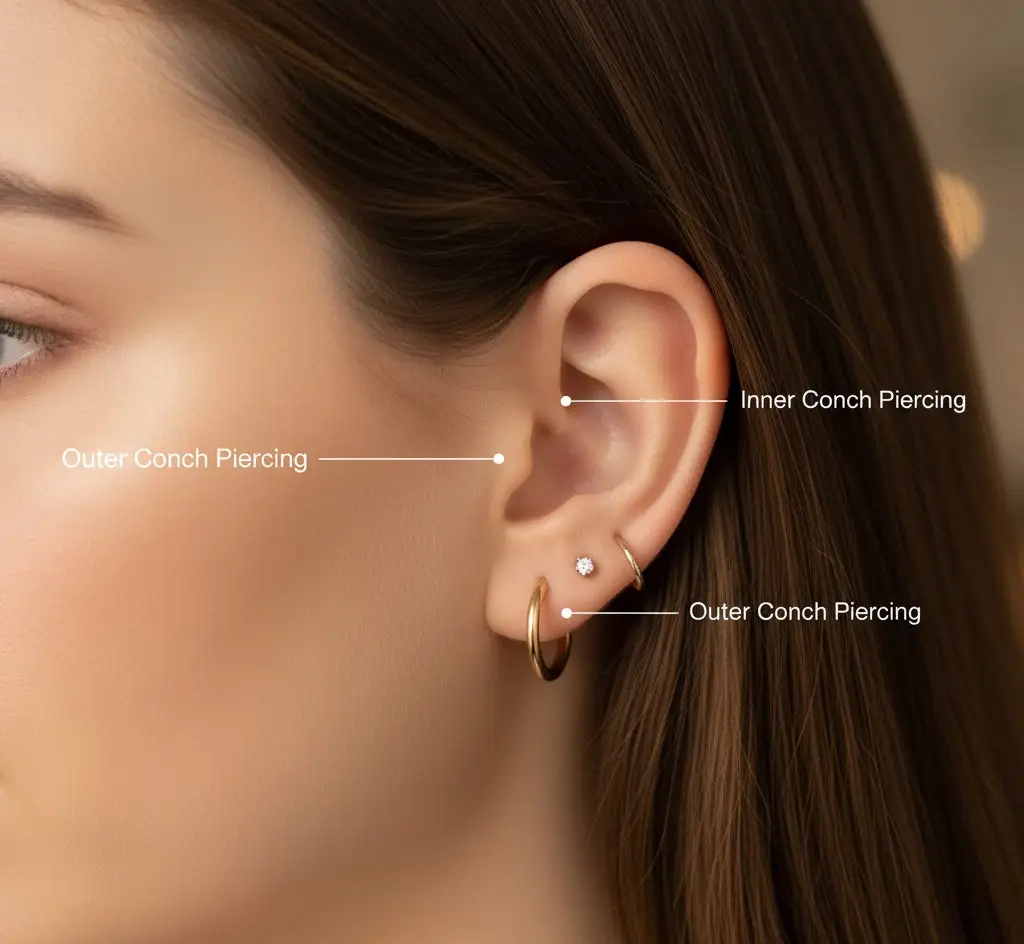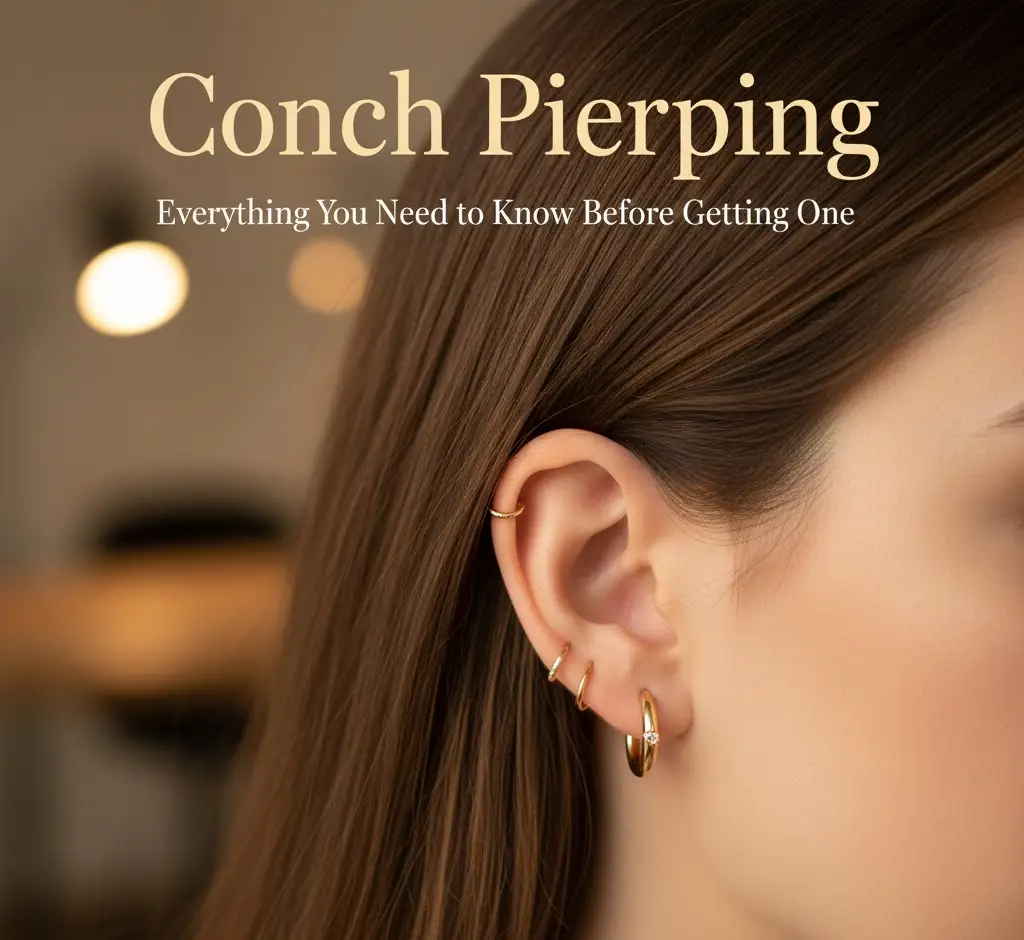If you are passionate about ear piercings and want something distinctive and fashionable, you should consider getting a conch piercing. It’s extravagant, stunning, and has the potential to elevate your ear to a conversation starter piece. However, before you consider getting one, you must learn what conch piercings are, the procedure to get one, and how to care for them and the expected transition during the healing period.
What Is a Conch Piercing?
A conch piercing is a type of ear cartilage piercing located at the center of your ear. It is named after the “concha,” which is the curved inner shell of your ear, and resembles a seashell (conch). There are generally two main types, depending on where you go on the conch.
Inner conch piercing: This goes through the inner cartilage and is placed closest to your ear canal.
Outer conch piercing: This sits on the flat outer cartilage and is typically where people wear hoops that go around the ear.

Both types look incredible and offer a variety of creative options for jewelry.
Why People Love Conch Piercings
Conch piercings are especially popular with those seeking a piercing that is slightly more sophisticated than a standard lobe piercing. One of the primary reasons for this is because of the piercing’s versatility. Conch piercings can be adorned with simple studs of varying sizes, large hoops, and can be incorporated into an array of other piercings for a more elaborate “curated ear” look, thereby providing a wide range of options for conch piercing jewelry.
Conch piercings are an excellent way of featuring a good deal of individuality. They can be adorned in a variety of different piercings ranging from minimalist to more elaborate designs. Regardless of the style, they provide an eye-catching finishing touch that contributes to the overall design of the piercing.
The Piercing Process
It is essential to get a conch piercing done by a professional piercer in a clean and reputable studio. Attempting to do it at home is very unwise because this type of piercing requires considerable skill and the piercing of cartilage is a more complex procedure that requires precise and sterile tools.
The following is an outline of the conch piercing procedure:
- Consultation: The piercer asks the client what type of conch piercing they would like.
- Cleaning: The ear is disinfected to help prevent infection.
- Marking: The piercer uses a pen to mark the area where the needle will pierce.
- Piercing: The piercer uses a sterile needle to make the piercing.
- Jewelry Insertion: The jewelry of the client’s choice is placed, which is typically a stud or small hoop.
Although the process takes only a few minutes, the individual may feel short sharp pain or pressure. Since everyone has different levels of pain tolerance, most people describe the process and the pain as a quick sting, not as intense pain.
How Long Does It Take to Heal?
For a conch piercing, healing time can depend on aftercare and your body’s healing rate. Generally, healing time can range from 6 to 12 months. Remember that cartilage takes longer to heal as compared to soft tissue, so patience will be needed.
In the first few weeks, some degree of inflammation is to be expected in the form of some redness, swelling, or mild soreness. This is perfectly normal. If the area is hot, painful, or has discharge, this may be an infected area, and you should contact a piercer or your primary care physician.
Proper Aftercare for a Conch Piercing
Your new piercing deserves your attention. If you do not care properly it may result in prolonged healing time. Rest is the key, and so is not healing your piercing.
-
Clean twice daily: Use a saline solution or sterile piercing spray. Avoid alcohol or hydrogen peroxide as they can dry out the skin.
-
Avoid touching: Only touch your piercing with clean hands. Don’t twist or rotate the jewelry.
-
No sleeping on it: Try not to sleep on the pierced ear, especially during the early healing phase.
-
Avoid swimming: Stay away from pools, lakes, or hot tubs until it’s healed.
-
Keep hair and products away: Be careful with hair products, perfumes, or lotions that might irritate the piercing.
Consistency matters more than over-cleaning. Stick to a simple, gentle routine.
Choosing Jewelry
A flat-backed stud is a good piece of initial jewelry; it is less likely to catch on things and is comfortable to wear. After it has healed, you may use hoops, rings, and decorative barbells instead.
Always ensure your jewelry is made of titanium, surgical steel, and 14k gold, since these materials minimize irritations and allergic reactions. You should avoid anything made of base metals.
Also Read: SkinPres T: Revolutionizing Skincare with Smart Technology
Pain and Risks
The average person will ask, “Conch piercings hurt?” People will describe the duration and type of discomfort associated with a piercing as a dull soreness for ’a few’ days, and it is considered a moderate inconvenience.
The risks are usually minimal if you see a professional, but there are always potential problems with any piercing, such as:
- Infection due to insufficient hygiene or unsterilized equipment.
- Swelling or irritation due to friction or poor-quality jewelry.
- Keloids or other complications if your skin has an adverse reaction to the piercing.
Always select a professional piercer and adhere to aftercare guidelines to eliminate these risks.
When Can You Change the Jewelry?
Jewelry can only be changed after a piercing has completely healed, which can take a minimum of 6 months. Changing jewelry before this healing period can result in irritation, and the hole may close. If you are unsure, your piercer can evaluate it and assist with the jewelry change.
Styling Ideas for a Conch Piercing
After a conch piercing has healed, there are limitless options. One modern and balanced style involves a conch hoop with a helix and tragus piercing. For a more minimalistic style, a single gold stud in your conch is an effortlessly chic option.
Varying the size and texture of your jewelry will create more dimension to your ear design — and this is what is trending as the “curated ear.”
Conclusion
Getting a conch piercing is not a simple fashion statement; it is a design of your own creativity and a reflection of your self-confidence and self-expression. No matter your piercing style, minimalistic or bold, it is likely to go with any aesthetic you desire.
A beautiful and healthy conch piercing is a stunning and timeless piece of jewelry. Remember, with proper care and the passing of a few weeks your allergy to metal will likely be a thing of the past.
Conch Piercing Questions
1. How much will a conch piercing cost?
Conch piercings vary from $40 to $90 plus jewelry depending on the location and the studio.
2. Can I sleep on my conch piercing?
Yes, but it is advisable to wait to sleep on the pierced ear until it is fully healed.
3. What type of jewelry should I wear?
A flat-backed titanium stud or a piece of surgical steel is preferred and recommended.
4. Can I have both ears pierced?
Yes, provided you do not sleep on either side of your body. This is to help the ears heal after the piercing.
5. How do I know if my conch piercing is infected?
Look for the presence of redness, swelling, pain, or pus. In the case of persistent symptoms, medical attention should be sought.
Also Read: Top 10 Best Nail Salons Near Mexico City: Pamper Yourself in Style
For more engaging content and the latest updates, follow Bunk knot for insightful articles and fresh perspectives!
Also follow: mastodon.social/@bunkknot


